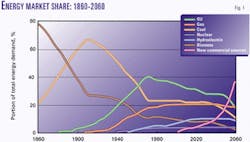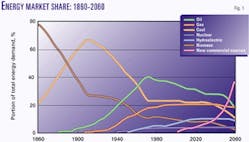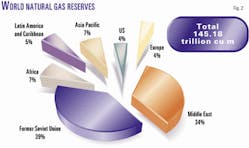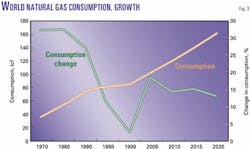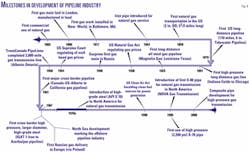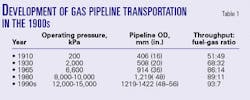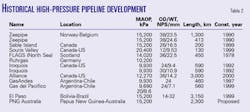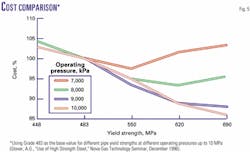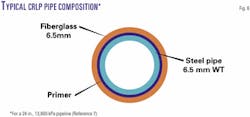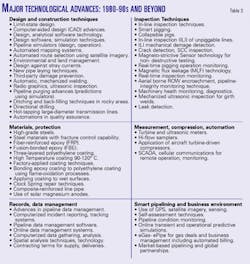Rapid, worldwide growth in natural gas as a fuel of choice has challenged the world's pipeline industry to maintain safety and reliability and reduce costs by devising innovative techniques in planning, financing, marketing, and technical developments.
To achieve these goals, future pipelines will utilize a combination of high-pressure technologies, high-strength steels or alternative fiber glass composite materials to make longer and higher capacity pipelines more feasible.
Advancements in rehabilitation, maintenance, monitoring, predictive, and operational control technologies have proven long-distance transmission pipelines reliable and safe without imposition of safety regulations that have been based on inaccurate assessments of pipeline systems' maintainability and operation.
Gas use, pipelines grow
The end of 20th Century has seen major developments to pipeline technology and the pipeline transmission business. In North America and Europe, the trend has been towards deregulation and development of market-based systems. In other markets, fixed-transportation-cost contracts between shippers and the pipeline industry have prevailed, particularly for long-term arrangements.
World energy consumption in the past decade has increased by 15%, and the US Energy Information Administration predicts that by 2020 this increase will be up by 55% over current consumption.1 But the trend has been towards use of more environmentally friendly energy forms, such as natural gas and electricity. Since the early 1900s, the gas industry has grown to the extent that today it accounts for approximately 20% of total world energy demand.
To support this growth, pipeline infrastructure has grown by a factor of 100 in approximately 50 years. It has been estimated that world pipeline expansion will be in the order of 7%/year over the next 15 years.2
Pipelines have taken a major role in industrial development, in particular in the developing nations, as pipeline and industrial development have been closely linked: Wherever there is the largest pipeline network, there is also highest technological advancement and a better living environment.3
Industry forecast for North America is for more than 85,000 km (nearly 53,000 miles) of new transmission pipelines to be built 2001-2010 at an estimated cost of slightly more than $80 billion. This does not account for any rehabilitation or distribution network. Consequently, corresponding global expenditure (including North America) for pipeline development for the same decade could be on the order of $120 billion, higher than previous predictions.
North American pipeline development will be significant due to tapping northern (Alaskan and Canadian) gas reservoirs, meeting the ever-increasing demand for gas in the US. Outside of demand, northern pipeline development will be more attractive due to the technological advancements in pipeline materials, construction, design methodologies, right-of-way environmental management techniques, satellite imagery, and others that have major effects in cost reduction for pipeline transportation and project economics.
World energy; milestones
Fig. 1 represents a 200-year snap shot of the market share of major fuel types.4 Included in this window is a projection of approximately 60 years into the future, to 2060. Viewing an extended period of time reveals the major changes that have taken place in energy use and accompanying developments.
Petroleum fuels that are so common today had no market share in 1860 but then appear in various levels of decline by 2060. Within 20 years, natural gas will overtake coal and within 60 years will overtake oil. Also within 60 years, new commercial sources of energy such as wind and solar power will likely be established.
Fig. 1 clearly shows the increasingly important position of natural gas in the global picture of both the near and distant futures. While discussions focus on natural gas, supply, and transportation for the next 20 years, it should be noted that natural gas is not a renewable resource and will someday be depleted.
Natural gas global reserves (Fig. 2), production, and consumption (Fig. 3), however, indicate that natural gas will account for the largest projected increment in energy use between 1999 and 2020.1 The trend of past 30 years has been taken into account for projection into the next 20 years because projection over an extended period of time can be misleading.
Fig. 3 also represents the percentage of growth and decline in consumption.
To understand better the role of pipelines in energy transportation, it is best to review the historical developments in the pipeline and energy industries over the past 200 years. Fig. 4 shows the major milestones, among the most significant to the pipeline industry are:
- 1891: The first high-pressure long distance pipeline went into service.
- 1961: Canada and the US were connected.
- 1967: First international cross border, high-grade steel pipe (X-65) was built between Iran and Russia.
- 1967: North Sea development began.
- 1971: First use of X-70 in Canada (Alberta Gas Trunkline Ltd.).
- 1995-96: First use of high strength, high-pressure (2,200 psi) pipeline.5
- 2000: First high pressure, high-grade steel between US and Canada went into operation Alliance pipeline system).
In 1998, there were more than 857,000 km of natural gas pipeline worldwide,6 almost 50% of which was in North America. This is followed by Western Europe with about 24% of the world's natural gas pipelines.
Between 1948 and 1999, about 1.7 million km of transmission pipelines were built to serve the industry.2 More than 54% of the lines was built to transport natural gas.
To meet ongoing demand for natural gas, a great deal of pipeline construction continues to take place. At the beginning of the most recent 2-year period (1998-2000), the International Pipe Line and Offshore Contractors Association reported construction plans for 85,000 km of new pipeline including 55,000 km of natural gas pipeline. (These figures exclude the former Soviet Union and China.)7
Trends
Historically, the safe design of a pipeline has been related to a limitation of the hoop stress as a function of the material yield stress. This relationship uses the Barlow formula and hence is a function of the internal pressure, pipe OD, and pipe WT. In the early 1900s, the pipe was low strength and provided limited economic capabilities in terms of pipeline technology. Table 1 illustrates this point, showing the development of pipeline gas transport through the 1900s.
From late 1990s and into the 2000s, there are new projects with pressures up to 20 MPa (in, for example, the Souris Valley, Table 2)7 but relatively small diameter, although there are currently discussions on the use of high-pressure pipelines up to 1,220 mm OD.
The big change in technology occurred with the introduction of high strength low-alloy steels in the 1960s and is discussed presently.
The main impetus for the increase in pressure and in material properties is economics. On a large-diameter pipeline project, 40-50% of the cost is related to material. Reducing the material cost, therefore, significantly affects project costs.7
Fig. 5 clearly illustrates the benefit of using higher strength materials and suggests the driving force for increasing strengths to even higher values. Currently, Grade 550 (X-80) has been used extensively by TransCanada PipeLines Ltd. and is being applied to other pipeline construction today.8 The trend is to develop Grade 690 material, discussed presently along with other materials.
Accompanying these increases in material yield strength are increases in operating pressures. Although Fig. 5 shows the benefit in terms of cost, this must be balanced against pipeline design and consideration of diameter-wall thickness ratios (D/t) together with strain limits and constructability issues.
The major changes that are occurring in construction technologies relate primarily to the continued expansion of mechanized and automatic techniques. Mechanized welding is now a standard technology and has seen considerable advances in the previous few years including the use of one-sided welding, multiple-arc technologies, and alternative welding technologies.9 The thrust is to move mechanization more towards automation.
Changes in welding technology have also been accompanied by changes in inspection technology. Mechanized ultrasonic inspection techniques are now commonplace for both mechanized welding and manual welding. Changes occurring in this field relate to the introduction of phase-array technology and improved sensitivity with respect to defect detection.
Accompanying these changes has been the widespread use of alternative acceptance criteria based on engineering analyses while maintaining structural integrity. These technologies have resulted in considerable economic benefits for the pipeline industry and have improved the structural reliability of pipeline systems.
Emerging trends relate to the combination of these technologies into the pipe laying sequence that will permit a single station for pipeline construction. These technologies are being used both onshore and offshore.
Environmental concerns with river crossings, sensitive habitat, and crowded pipeline right-of-way have led to increasing applications of directional-drilling installations and the trend has been to larger diameters and longer pulls. Related to the environment are continued efforts to minimize right-of-way impact and improve reclamation techniques, all of which have seen considerable changes in the last decade.
Assessment of pipeline safety continues to be a major topic, and understanding of risk and reliability in system operation has led to many innovations. The pipeline industry now uses strain-based designs and is working towards incorporation of reliability-based designs.
In addition, pipeline operators worldwide have been implementing processes and changes to operate and maintain existing pipeline assets more efficiently, cost effectively, and more safely.
Recent developments include consolidation of control rooms into larger more cost effective control centers that allow pipelines to be operated on a continental basis. Also, use of satellite technology will allow intercontinental operation and control of pipeline operations to become a reality in the near future.
To minimize the contribution of human error to accidents and incidents on operating pipelines, operators worldwide are implementing processes to ensure their operations and maintenance work force is well qualified to perform the tasks necessary to operate pipelines safely and efficiently.
The Operator Qualification Rule introduced by the US Department of Transportation's (DOT) Office of Pipeline Safety has been a catalyst in this development. Non-DOT regulated pipeline operators are implementing similar processes.
The use of monitoring and control technology has seen a steady evolution since its inception more than 30 years ago. New developments in supervisory control and data acquisition (SCADA) have transformed control functions from a basic monitoring operation into a system that can provide data and computations to perform a number of complex functions.
SCADA systems now collect data that were typically collected manually (for example, rectifier readings), and SCADA is also delivering training functions to control center operators. Upstream operators are using the internet for web-based monitoring of their production facilities in a manner that pipeline operators may adapt for their systems in the near future.
The desire to operate pipelines cost effectively is driving development of new in-line inspection techniques including use of new methods for crack detection and use of dual diameter in-line inspection tools. To reduce the impact on shippers, operators of pipelines of various diameters have approached in-line inspection tool vendors to develop tools capable of operating and collecting data in pipelines of different diameters in a single inspection run.
Associated with integrity has been introduction of an entirely new era of pipeline-inspection technologies based on crack detection including electro-magnetic acoustic transducer (EMAT) technologies, which can be used to introduce ultrasonic energy into the pipeline steel without liquid coupling and in direct contact with the steel. These developments have primarily been in response to the occurrence of stress corrosion cracking on major pipeline systems.3
Current developments
The major change that has occurred in steel pipeline technology was introduction of high-strength low alloy steels (HSLA), the essential characteristics of which:
- Fine grain size for good yield strength and toughness.
- Low carbon and carbon equivalent for good toughness and weldability.
- Chemistry control including micro-alloying with niobium, vanadium, titanium, and aluminum.
- Process control and controlled rolling.
These changes led to higher strengths, improved toughness at low temperatures, improved weldability, improved resistance to sour service, improved ductile fracture resistance, and cost effectiveness.
And these changes have now been incorporated into a new generation of pipeline steels, for example Grade 690 (X-100), which is currently under development with potential application in high-pressure systems.10 11
These steels utilize modifications to the low alloys somewhat but also incorporate changes to the process control in the form of controlled rolling and accelerated cooling. The next generation of pipeline steels is just beginning to be developed and will have strengths in order of Grade 830 (X-120).
Increased interest is appearing in the potential use of composite-reinforced line pipe (CRLP) as a potential application for transmission pipeline systems and for gas transport modules.7 CRLP uses a patented glass-resin reinforcing technology developed by NCF Industries Inc. and is currently under further development by Trans Canada (Fig. 6).
Composite-reinforced gas transportation products are based on the concept of composites adding hoop strength to steel line pipe or vessels. The steel and composite over-wrap work in unison creating a hybrid product that carries the applied load of high-pressure gas. The advantage of the combined system is that high strengths can be achieved at high pressures while still offering enhanced pipeline integrity cost-effectively. CRLP is currently being introduced into the pipeline industry with trials being performed on the TransCanada system.
Fiber-reinforced polymeric (FRP) composites currently used in pressure-retaining structures appear an alternative to conventional materials for pipe line systems. Some of the benefits of these composites relate to their corrosion resistance and their high strength-to-weight ratio.
The resistance in adopting composite materials, however, results primarily from limited understanding of material behavior under a variety of loading and environmental conditions and lack of qualified design methodologies. The eventual use of FRP pipe will need to overcome the following before its acceptance for high-pressure gas transmission:
- Public perception of using "plastic" for high-pressure gas transmission.
- Potential in minimizing impact of pipelines on the environment in geo-technically sensitive areas.
- Acceptance of high-pressure gas transmission by the public and communities and by regulatory bodies.
- Limited experience in implementation of the technology.
Ongoing research at the University of Alberta and other research centers aims to overcome these limitations.12 Practical application of composite pipeline technology could be less than 5 years away.
The advantage of FRP composites over conventional materials is their relative high strength, light weight, corrosion resistance, and durability. The weight reduction translates into direct cost savings (providing no premium is expected in comparison to steel) as a result of reduced handling and installation costs, while improved corrosion and durability result in a long-term operational and maintenance cost benefit.
Furthermore, composite pipe technology has other advantages:
- Strength properties can be tailored for a particular loading application, that is, designed and fabricated for the characteristics of a particular region.
- "Smart technologies" (for example, embedding chips into the composite to detect pressure changes and possible leakage) can be incorporated into composite structures that can provide for remote monitoring of structural integrity or possible indications of failure.
- Composite structures can be designed to "leak before break," which can be incorporated into a structural reliability approach. In addition, well-established manufacturing technologies (for example, filament winding) exist for fabrication of composite pipe.
FRP composites are beginning to be used extensively offshore, primarily because of their high strength-to-weight properties and corrosion resistance.13 14 In onshore pipeline applications, use of composites has so far been restricted to small-diameter oil and gas flowlines, particularly in corrosive environments (for example, enhanced oil recovery). Current research aims to extend this application to large diameter high-pressure pipelines.
Other advancements
To meet the challenges of future growth, significant research, development, and improvement are ongoing in the gas transmission industry, in areas and subjects shown in Table 3, but not limited to these.2
One of the technologies which most affects the capital cost of a pipeline project is that of high-strength steel or alternative materials, as previously indicated, and their application in design (limit state) and high-pressure operations (greater than 15,000 kPa (2,200 psi).7 15
Among the challenges to newer pipeline projects are the following:16
- Risk-return relationships.
- Ever increasing distances.
- Regulatory and environmental effects.
- Public and government perceptions.
- Ever greater market pressures on cost effectiveness as a result of free-market enterprise.
- Ever greater need for contracting flexibility.
- Ever greater need for fast, more complete, more accurate information.
- Limitations caused by project-specific corporate structures and financial arrangements.
- Changing customer needs.
Today's pipeline systems began more than 50 years ago with the invention of high-strength steel pipe and methods for welding it. Most of the transmission systems today use high-strength steel, but more than 50% is older than 40 years. The system, however, is continually monitored, maintained, upgraded, and has the best safety record in the energy industry. Today, pipelines face new challenges after being tightly regulated since 1938.17
All these forces will influence the path and future of gas pipeline transmission. Consequently, the challenges facing the industry are how to continue not only to work in innovative ways to improve operational safety but also to do business in an era of decreasing regulation, open access, and public awareness.
Acknowledgment
Permission granted by managements of TransCanada PipeLines Ltd. and Enbridge Technology Inc. for the publication of this article is gratefully acknowledged.
References
- "International Energy Outlook 2001," US Energy Information Administration, US Department of Energy, Washington, March 2001.
- Mohitpour, M., Dawson J., Babuk, T., and Jenkins A. "Concepts for Increased Natural Gas Supply: A Pipeline Perspective," 16th World Petroleum Congress, Calgary, June 11-15, 2000.
- Mohitpour. M., McManus. M., "Pipeline System Design, Construction and Operation Rationalization," 1995 ASME 14th International OMAE Conference, proceedings, Vol. V, Pipeline Technology, pp. 459-467.
- McKnight, J., Transportation in the 21st Century. Latimer Trend & Co. Ltd., Plymouth, UK, 1998.
- Piper, J., and Morrison, B., "The International Database of Full Scale Fracture Tests and its Applicability to Current Australian Pipeline Design," International Seminar on Fracture Control in Gas Pipelines, June 3, 1997.
- Ives, G., "Pipeline Companies Plan to Lay 22,200 miles in 1998," Pipeline & Gas Industry, January 1998, pp. 39-42.
- Mohitpour, M., Van Egmond, T. and Jenkins, A., "High Pressure Gas Pipelines - Trends for the New Millennium," International Pipeline Conference, Oct. 1-5, 2000, Calgary.
- Glover A.G., Horsley, D.J., and Dorling, D.V. "High-Strength Steel becomes Standard on Alberta Gas System," OGJ, Jan. 4, 1999, p. 44.
- Glover, A.G., Hodgkinson, D., and Dorling, D.V. "The application of Mechanized Ultrasonic Inspection and Alternative Acceptance Criteria to Pipeline Girth Welds" Pipeline Technology Conference, Ostende, October 1990.
- Barsanti, L., Pozzoli, G., Hillenbrand, H.G., "Production and Field Weldability Evaluation of X100 Line Pipe," 13th Joint Technical Meeting, PRCI and EPRG, May 2000.
- Private communications from NKK, Sumitomo, Nippon Steel, Kawasaki Steel, Europipe, IPSCO, and Stelpipe.
- Ellyin, F., Wolodko, J., Dorling, D.V., Glover, A.G., and Jack, T. "Fibre Reinforced Composites in Pipeline Applications: Design Issues and Current Research," International Pipeline Conference, Oct. 1-5, 2000.
- Vennett, R. M., Williams, J. G., Lo, K. H., and Ganguly, P. "Economic Benefits of Using Composites for Offshore Development and Operations," in Composite Materials for Offshore Operations - 2; ABS, 1999.
- McDonnell, P., and McNamara, J. F., "Evaluation of GRP Composite Pipelines for High Performance Offshore Applications," Key Engineering Materials, Vol. 99-100, 1995.
- Mohitpour, M., "Some Technical and Economic Aspects of High Pressure, Long Distance, Large Diameter Gas Transmission Pipelines," 6th AIRAPT International High Pressure Conference, University of Colorado, Boulder, July 25-29, 1974.
- Von Basseheim G., Mohitpour M., Klaudt, D., and Jenkins A., "Challenges in the Development of Market-Based Pipeline Investments." 2nd Congreso Latino Americano y del Caribe - Gas Y Electricidad, Punta del Este, Uruguay, March 2000.
- Thompson, Hugh A. "Moving Natural Gas from Wellhead to Burner Tip," GRID Gas Research Institute Digest, Vol. 13, 1990, pp. 2-12.
The authors
Mo Mohitpour is president of Tempsys Pipeline Solution Inc., Calgary, and a principal consultant with Enbridge Technology Inc. for projects in Oman, Brazil, and Colombia. He has more than 20 years' experience in engineering, construction, and management of pipeline systems and associated facilities for oil, gas, condensate, batched products, specialty fluids transmission, storage, tankage, and distribution. He is a registered professional engineer in several US states and a fellow of the American Society of Mechanical Engineers, the Institution of Mechanical Engineers (UK), and the Engineering Institute of Canada.
Alan Glover is a technology Leader with TransCanada PipeLines Ltd., Calgary, and works on materials, fracture, and structural integrity issues. He holds a BSc in metallurgy from the University of Leeds, UK, and a PhD in fracture and fracture mechanics. He is a registered professional engineer in Alberta.
Bill Trefanenko is currently manager of technology transfer for Enbridge Technology Inc., Edmonton, and has more than 24 years' experience in the oil and gas pipeline industry involving engineering design, construction, project management, operations, integrity and rehabilitation, maintenance, and management in both owner-operator and engineering consulting companies. He has managed projects in a number of countries, including Malaysia, Russia, Argentina, Chile, and Mexico.
